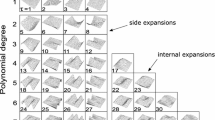Abstract
The recent application of tube hydroforming in the automotive industry demands finite element analysis, since it is rapidly being used as an effective tool for the evaluation and optimisation of the design of hydroforming dies and processes. In this paper, attention is paid to the comparison of an implicit and an explicit FEM widely used for the hydroforming process. The influences of time scaling and mass scaling, which have been commonly used in order to save computational time in the explicit method, are especially investigated. The comparisons focus on the predictability of wrinkling and stress with various scaling factors in the explicit method. Through verifications with experimental results, a useful guideline in determining the scaling factors is proposed.







Similar content being viewed by others
References
Koc M, Altan T (2001) An overall review of the tube hydroforming (THF). J Mat Proc Technol 108:384–393
Jung DW, Yang DY (1998) Step-wise combined implicit-explicit finite-element simulation of autobody stamping processes. J Mat Proc Technol 83:245–260
Wang SP, Choudhry S, Wertheimer TB (1997) Comparison between the static implicit and dynamic explicit methods for FEM simulation of sheet forming processes. White papers of the MARC Corporation
Sun JS, Lee KH, Lee HP (2002) Comparison of implicit and explicit finite element methods for dynamic problems. J Mat Proc Technol 105:110–118
Rebelo N, Nagtegaal JC, Taylor LM (1992) Industrial application of implicit and explicit finite element methods to forming processes. Numerical Methods for Simulation of Industrial Metal Forming Processings ASME, Balkema, Rotterdam
Kim J, Lei LP, Kang BS (2002) Manufacture of an automobile lower arm by hydroforming. Int J of Machine Tools Manufact 42:69–78
Kobayahsi S, Oh SI, Altan T (1989) Metal forming and the finite element method. Oxford University Press, New York
Mattiasson K, Bernspang L, Samuelsson A (1996) Solution of quasi-static, force-driven problems by means of a dynamic-explicit approach and an adaptive loading procedure. Engin Computat 13(2/3/4):172–189
Chung WJ, Cho JW, Belytschko T (1998) On the dynamic effects of explicit FEM in sheet metal forming analysis. Engin Computat 16(6):750–776
Acknowledgements
This work was completed with the support of the ERC/NSDM, Pusan National University, Korea, which the authors gratefully acknowledge. The last author would also like to acknowledge the support of the 1999 Research Fund Program of Pusan National University.
Author information
Authors and Affiliations
Corresponding author
Rights and permissions
About this article
Cite this article
Kim, J., Kang, SJ. & Kang, BS. A comparative study of implicit and explicit FEM for the wrinkling prediction in the hydroforming process. Int J Adv Manuf Technol 22, 547–552 (2003). https://doi.org/10.1007/s00170-003-1540-2
Received:
Accepted:
Published:
Issue Date:
DOI: https://doi.org/10.1007/s00170-003-1540-2




